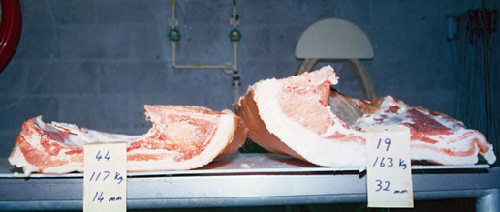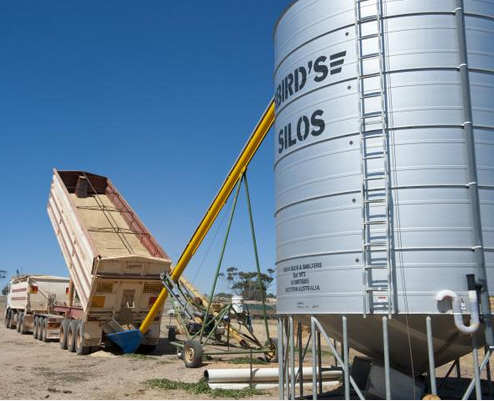



Controlling High Backfat (P2) in Finisher Pigs
An overview of the factors contributing to increased backfat and measures to manage P2 levels from the Department of Agriculture and Food at the Government of Western Australia.There are a number of factors that may contribute to pigs having high backfat (P2) and therefore graded fatter than what is required by the market. Control measures can be put in place to increase carcass quality and manage P2 levels.

Factors Contributing to Increased Backfat (P2)
1. Genotype
The aim in pig breeding is to select later-maturing animals as these have a greater genetic capacity for rapid lean growth up to slaughter weight. Poorly selected stock tend to be slower growing and fatter at slaughter. When producers select their own replacement stock, they run the risk of reducing the genetic potential of their stock if they select for rapid growth but not rapid lean growth (which requires a measure of P2 to be taken into account in the selection process). Breeding companies can assist with providing animals or semen to reduce P2 and increase lean meat yield.
2. Sex
Since entire males are later maturing than females, they tend to be leaner at a given slaughter weight than females and are more efficient at converting feed to lean tissue. The differences between entire males and females are reducing as genetics continue to improve. Castrates will perform more like females, hence are likely to be fatter at slaughter than entire males. Immunocastrates are typically somewhere between a female and an entire male but this depends on when the second vaccination is given.
3. Distorted growth patterns
Pigs that have a growth check, for whatever reason, are known to be able to compensate when conditions improve. If feed intake is restricted during the grower phase (up to 50kg liveweight) due to overstocking, poor health etc, then access to feed improves during the finisher phase, pigs will eat more nutrients than they are capable of utilising, with excess nutrients converted into fat.
4. Diet specifications
Highly selected genotypes have higher protein deposition rates than poorly selected genotypes and both must be fed diets that meet their requirements. If highly selected genotypes are fed a diet low in protein (amino acids), then their potential for deposition of lean muscle will not be met and they will convert excess energy into fat stores. Conversely, poorly selected pigs fed a high protein diet will not be capable of utilising much of that protein and will consequently also direct excess nutrients into fat stores.
5. Liveweight/age
As a pig grows towards its mature body size and weight it deposits relatively more fat and less muscle. Pigs held back for different reasons (e.g. illness or injury) are as a consequence more mature than their pen mates of the same bodyweight and more likely to have higher P2s.
6. Change in grading schedule
Grading schedules can change. If there is an increase in the proportion of pigs missing the top grade, check that there hasn’t been a change to the carcass weight and/or P2 requirements.
7. Excess intake
All pigs have a set genetic potential for growth. If for whatever reason pigs consume nutrients (energy and amino acids) in excess of what they can utilise, then the animal will convert these into stores of fat.
8. Irregular intake
As with a distortion of growth pattern, it is possible that even short-term disruptions to feed intake may affect carcass quality. For example, a pig that consumes 1kg on one day and then 2kg the next, will end up being fatter than a pig that consistently consumes 1.5kg every day.
9. Pigs fed the wrong diet
If pigs are fed the wrong diet, then the nutrient supply does not match the pig's requirements and an increase in P2 could result. This may occur if the wrong diet is delivered to a pen of pigs but it may also happen if there is a large variation in liveweight within a pen of pigs. Hence it becomes impossible to meet the requirements of all animals.
10. Separation of the diet
If the diet is not mixed well enough or through delivery there is separation of nutrients (especially important micro-ingredients such as lysine), it will lead to irregular nutrient intake and hence a likelihood of greater variation in pig’s P2.
11. Poor feed ingredient quality
If the quality of ingredients (such as grains or protein meals) is not as good as was assumed when the diet was formulated, then the diet may supply inadequate nutrients. Therefore the requirements of pigs of high genetic potential are not met causing them to have higher P2s at slaughter.
12. Season
Pigs are very sensitive to changes in ambient temperature and this can be reflected in changes in feed intake. As mentioned previously, irregular intakes and a distortion to the pattern of growth will often lead to poorer carcass quality.
Ways to Control P2
1. Monitor performance
Accurate data on pig performance is important so that changes to management are made for the right reason. While average growth rates are better than nothing, measurement of individual weights several times through the growing phase (e.g. every four weeks) will indicate the spread in genetic potential and highlight which animals might be causing the problem with high P2s.
2. Check stocking rates and access to feed
It is all too easy to overstock pens, especially shelters when pigs are first introduced. Insufficient access to feed and water on a regular basis is a major contributor to poor carcass quality. If pens must be overstocked at entry, be prepared to remove either the heaviest or lightest pigs after a few weeks.
3. Check feed quality
This relates primarily to the quality of the raw materials being used to prepare diets, since it is difficult and expensive to measure the nutrient content of a mixed feed. However, an examination of the mixing procedure by an external party may identify better ways to mix feed that minimise the chances of errors being made.

4. Alter diet specifications
Reducing the energy content of diets (digestible energy or DE) will help reduce energy intake and hence avoid pigs depositing excess body fat. However, with the limited range of ingredients available it is difficult to reduce DE below ~12.5 MJ/kg in a finisher diet. Keep in mind that feed conversion will deteriorate if very low energy diets are fed so the cost of feed per pig may offset any improvement in $/kg.
5. Use feed additives
A number of feed additives and management tools are available that may help reduce P2. These should not be seen as a way to overcome poor management. It is recommended that producers discuss these options with their nutritionist.
6. Alter sale arrangements
The option of selling pigs known to be causing the problem with high P2s at a lighter weight might be a cost-effective option for some producers at least in the short-term. If females are known to be a major part of the problem, then selling them a week earlier and extending the sale age of the males by a week could be an option.
May 2014








